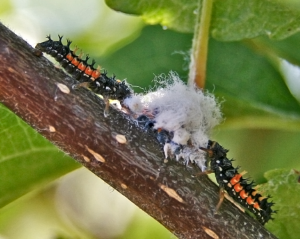
WSU has an active research group looking at ways to enhance orchard biological control. Biological Control (AKA Biocontrol) is a method of controlling pests through the use of natural enemies (NE’s). A good example of this is using lady beetles to help control aphids. Biocontrol can be used in concert with chemical control strategies if care is taken with application timing and product selection. The Enhancing Western Orchard Biological Control SCRI project focused on ways to improve the stability of IPM programs in apple, pear, and walnut orchards, by enhancing biological control. The project objectives were multi-pronged. The first was to look at acute and sublethal effects of various commonly used orchard pesticides to gauge the level of impact on various natural enemies. The second was to develop phenology models of some of the most important natural enemies ignored to predict when they were active in the orchards. The third was to develop and evaluate lures for monitoring natural enemy populations. The fourth was to develop a gut content analysis technique to determine what generalist predators were feeding on in orchards. The fifth was to look at the economics of utilizing biocontrol strategies. Then finally, the last objective was to determine the best mode of information dissemination to stakeholders, i.e., the best way to deliver research results in an outreach program. Full details about the project can be found at its dedicated website. Once the project completed, the complementary USDA/WSDA block grant project was undertaken to begin the prescribed outreach program. This project is still ongoing.
Primary WSU Resources
 |
 |
 |
| The Enhancing Western Orchard Biological Control website is an excellent primary resource for research results, NE identification, articles (both trade and technical), pesticide effects, videos and more. | Orchard Pest Management Online has a collection of both pest and natural enemy descriptions. The descriptions include information about their biology, behavior and phenology. | The WSU Crop Protection Guide doesn’t only have control recommendations. This guide also includes basic information about concepts of pest integrated pest management, resistance management and principles of biological control. |
Selected Resources for Biological Control
- Common natural enemies in WA tree fruit, V. Jones and S. Steffans, WSU-TFREC
- Natural enemies and beneficial insects, WSU Orchard Pest Management Online
- Using entomophathogenic nematodes for crop insect pest control, PNW pub. #544
- Using mulches to improve the efficacy and persistence of insect specific nematode control of overwintering codling moth, L.A. Lacey, et al., PDF poster
- NE Identification Guide Resources, Enhancing Western Orchard Biological Control, webpage
- NE topics video gallery, Enhancing Western Orchard Biological Control, webpage
- Watch out, codling moth! Spiders will eat anything they can physically tackle, including codling moth larvae and pupae, Good Fruit Grower, 2012
- Enhancing Biocontrol: natural enemies provide a free service that can contribute to pest control. U. Chambers, et al., Good Fruit Grower, 2013
- Enhancing Biological Control in Western Orchards, V. Jones, et al., 5-year report, 2013
- Evaluation of herbivore-induced plant volatiles for monitoring green lacewings in Washington apple orchards, V. Jones, et al., Biological Control 56 (2011) 98-105
- Natural enemy inventory, A. Bixby-Brosi, et al., Good Fruit Grower, 2013
- Enhancing BC in organic orchards: Using HIPV lures to characterize, monitor, and manipulate natural enemies, V. Jones, et al., presentation from Biocontrol workshop
- Using plant-produced odors to attract predators and aid biological control, D. James and T. Price, WSU Extension News
- Pesticide effects on key natural enemies, Enhancing Western Orchard Biological Control, webpage
- OPENED – Orchard Pesticide Effects on Natural Enemies Database, interactive tool, Enhancing Western Biological Control, webpage
- Pesticide Intervals and Impacts: NE relative impact guide, WSU Crop Protection Guide
- Your management program matters, U. Chambers, et al., Good Fruit Grower, 2013.
- Tree fruit IPM programs in the western United States: the challenge of enhancing biological control through intensive management, V. Jones et al., Pest Management Science, p1839, 2009
- Scientists study pesticide effects: The choice and timing of pesticide sprays can influence biological control, Good Fruit Grower, 2011
- A New Tool for IPM: Natural enemy models, A. Gadino, et al., Good Fruit Grower, 2013
- Quantifying phenology, V. Jones, et al., Enhancing Western Orchard Biological Control Progress Report Y1, 2009
- Knowing phenology improves management options, V. Jones et al., Enhancing Western Orchard Biological Control Progress Report Y2, 2010
- Knowing phenology improves management options, V. Jones, et al., Enhancing Western Orchard Biological Control Progress Report Y3, 2011
- Knowing phenology improves management options, V. Jones, et al., Enhancing Western Orchard Biological Control Progress Report Y4, 2012
- Knowing phenology improves management options, V. Jones, et al., Enhancing Western Orchard Biological Control Progress Report Y5-final, 2013
